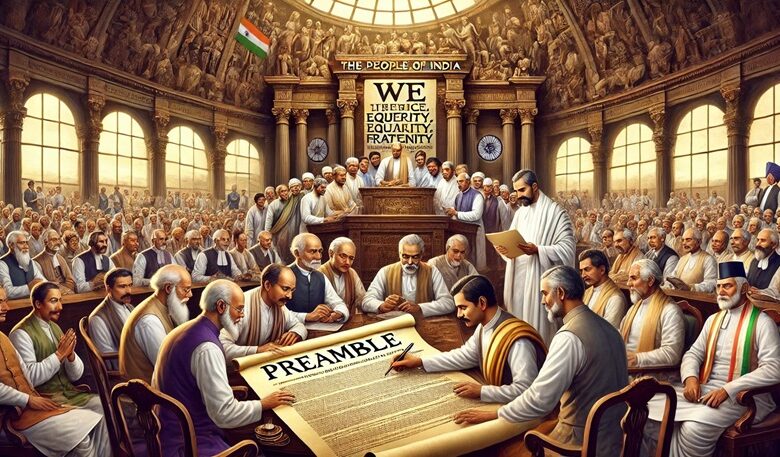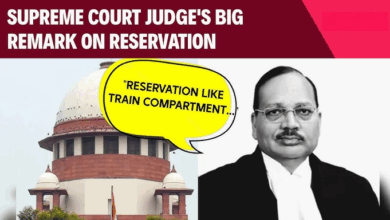How the Preamble clarifies guiding principles behind the Constitution
News Mania Desk / Piyal Chatterjee / 24th January 2025

As India gets set to honor its 76th Republic Day with the theme “Swarnim Bharat: Virasat aur Vikas” (Golden India: Legacy and Progress), the occasion also serves as a significant time to contemplate the fundamental principles of the Indian Constitution, effective from January 26, 1950. On this day, let us consider the essential values stated in the Preamble — Sovereign, Socialist, Secular, Democratic, and Republic — which form the bedrock of India’s democratic system, fostering justice, liberty, equality, and fraternity among all its people.
The preamble opens with the well-known and inspiring phrase, “We, the people of India.” This appeal to the populace is important as it sharply contrasts with the frequently unrestrained and passionate appeal to “the people” by modern populist movements globally. The individuals mentioned in the Preamble are depicted with a sense of seriousness, as a constitutionally guided group, which safeguards against the risk of such populist appeals to the people readily turning into tyranny.
After this constitutionally mediated invocation has occurred, the Preamble presents the fundamental ideas that the citizens of India have chosen to shape the republic: Sovereign, Socialist, Secular, Democratic, and Republic.
Sovereign: The word “sovereign” is among the most fundamental ideas in political science and constitutionalism. It pertains to three elements: first, sovereignty implies a dominance of authority that the state asserts, allowing no superior power; second, there is no chance or danger of disobedience from below the state that might endanger its unity; and third, this sovereignty is embodied in the popular representation in Parliament, which conveys the people’s will via universal adult suffrage.
Socialist: The word “socialist” did not exist in the initial version of the Preamble. It was added to the Preamble in 1976 via the 42nd constitutional amendment alongside the term “secular.” The inclusion of the term socialist in the Preamble has sparked some debate. Dr. B.R. Ambedkar opposed the inclusion of the term, believing that it would unjustly limit future governments. The term socialist faced challenges just last year when the Supreme Court, addressing a petition on the issue, decided in November 2024 that it should be retained since it has developed a specific meaning. Numerous critics have observed that, starting in the 1990s, India has initiated liberalization strategies of free markets, seen as contrary to socialism.
Secular: This is yet another term whose inclusion has been debated at different times, but its presence in the Preamble has provided it with a unique significance. The term secular, in contrast to its interpretation in the West, does not suggest an absence or denial of religion. Rather, it denotes that to uphold religious harmony among India’s diverse religions and belief systems, the state will adopt a secular position.
Democratic: The concept of democratic has acquired a notable Indian nuance because of its inclusion in the Preamble and the manner in which democracy has established itself in India. Shortly after gaining independence, elections took place in 1951 based on the principle of universal adult suffrage. Critics of Indian democracy have highlighted that significant poverty and illiteracy rates would be major obstacles to sustaining democracy, which typically flourishes in societies with a certain level of material prosperity. Nonetheless, several decades following independence, the achievements of Indian democracy have been recognized globally, with its dynamism and energy presenting a stark contrast to traditional Western liberal democracies.
Republic: The term republic in the Preamble is important in the historical journey of India’s independence from British colonial rule. In August 1947, India achieved autonomous dominion status within the British Empire following its independence. The national movement had long called for dominion status, which also led to the call for Poorna Swaraj (complete independence), initially articulated in 1921 and officially declared in 1930. It was only with India being declared a republic on January 26, 1950, that we progressed beyond the initial autonomy provided by dominion status. The word republic in the Preamble of the Constitution implies that the leader of the country must be an elected official rather than a royal heir, a practice that still exists today in the United Kingdom. It’s noteworthy that the idea of constitutional patriotism, first introduced by German social theorist Jurgen Habermas during the 1990s within a distinctly European framework, has developed a distinctive and vigorous character in India. The distinct enthusiasm for constitutional patriotism it has generated within the populace is profoundly shaped by the special importance attributed to the Preamble of the Constitution.
The significant Keshavananda Bharati case (1973) determined that the Preamble constitutes a component of the Constitution, aiding in interpreting the Constitution’s actual body. The Keshavananda Bharati ruling is especially important because it led to the creation of the “basic structure” doctrine of the Constitution and encompassed the Preamble within it. This judgement by a 13-member bench appeared to represent a shift from a prior ruling in the Berubari Union Case (1960), which did not consider the Preamble as a component of the Constitution, despite the fact that the Preamble was recognized as the ‘key’ to grasping the intentions of the Constitution’s creators.
In conclusion, contemporary Constitutions are significant texts that serve as a political agreement outlining the conditions under which the nation’s citizens will be governed fairly and legitimately. The Constitution of India holds the record for being the longest written Constitution globally. Considering the intricate details of the Constitution, the Preamble plays a crucial role in summarizing its core principles.






